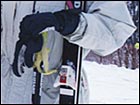|
Find your ride
|
 |
December 13, 2001: 12:21 p.m. ET
How to shop for skis, boots and bindings.
By Sarah Max
|
NEW YORK (CNN/Money) - Early skiers managed to get down the mountain on primitive wooden skis, and the first snowboarders did their best to rip it up on glorified cafeteria trays. Today, there are dozens of manufacturers, and each has its own high-tech recipe for improving your downhill experience.
But don't let a lot of the techno garble get in the way of finding the right ski. After you get a rough idea of the length and shape you need, the only way to really understand what ski or board is best for you is to take several kinds for a test drive. Manufacturers typically showcase their newest products with slope-side "demo days," where you can try several models for free. And most mountain shops will let you try the latest skis any time for around $35 a day.
Skis: For those who think two sticks are better than one.
So-called shaped skis are the most important new development in skis. Because of their hourglass figure, shaped skis make it possible for even beginner skiers to carve their way down the slopes. But not all shaped skis are created equal. In fact, the shaped-ski revolution has given birth to skis of just about every shape and size.
There is no single set of skis for everyone, but in general you want wider skis with a thicker waste (that's the middle of the ski) if you do most of your skiing in powder. These fat dimensions help keep your skis on top of the snow rather than under it. If you stick to groomed terrain you'll find that a thinner ski with a more dramatic shape will respond better on the turn. A good ski shop should talk with you about your ability and preferences to help you narrow down the field. To search for of the kinds of skis that suit your style, check out Ski magazine's SkiFinder.
There was a time when the length of your skis was a measure of your ability. In those days, skiers proudly strapped on 200-centimeter boards. Now the ski of choice is short and fat. "It's amazing how short you can go," said Joe Cutts, editor of Ski magazine, noting that a shaped ski should be 10 to 20 centimeters shorter than your straight-ski size. "I've been telling people that the ski tip should come up to your nose." Intermediate and freestyle skiers can go a little shorter while experts who prefer fast cruisers to mogul runs may go a little longer.
Bindings, which start at about $150, are what make it all come together. For most people, the only factor to consider with buying a binding is whether it will keep you in your ski while you're skiing and let loose when you fall hard. The force at which the binding releases, or DIN (For "Deutches Institut fur Normung" or German Institute for Standardization), depends on your weight and ability. This force can be adjusted on every binding, but bindings do have an optimum DIN. In other words, a novice skier doesn't want to buy a high-end binding and adjust the DIN too low and an aggressive or heavy skier doesn't want a low-end binding set too high.
Boards: The bad boys have gone mainstream
Ten years ago, ski resorts went out of their way to keep snowboarders off their slopes. Now that the number of boarders is growing faster than skiers, these same resorts are racing to build snowboard terrain parks and super half pipes. At the same time, snowboard manufacturers are working as hard as their old-school counterparts to improve every aspect of the sport's equipment.
One of the more significant innovations has been to the bindings. Traditional snowboard bindings strap on, which means you need to undo one foot and strap it on again every time you get on and off the lift. A few years ago, step-in bindings came on the scene and were scooped up by older riders or ski converts who didn't want to sit in the snow before every run. But while slightly more convenient, step in bindings have failed to reach mass appeal.
"Step in was all the buzz, but the pros and hardcore guys don't want to use them and neither do the kids," said Rick Steinle, merchandise manager for Sun & Ski Sports stores.
As with skis, you'll want to buy a board that's appropriate for your size and your style. Freestyle riders spend a lot of time in terrain parks and opt for shorter boards. Freeriders prefer carving at high speeds on longer boards. "Longer boards give you more speed and stability, and shorter boards are good for tricks and the pipe," said Emmet Manning, manager of Burton's factory store. 
|
|
|
|
|
|

|

